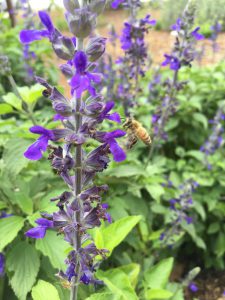
If I were to ask you to list some pollinators that visit your gardens, butterflies and honey bees may come to your mind. But take a closer look! Do you see a shiny little green sweat bee flying from flower to flower? Or possibly a hummingbird, moth or even a wasp? And don’t forget bats. Yes, bats also play a vitally important role in pollinating and spreading seeds. La Florida, the land of flowers, is home to a wonderful array of native and introduced pollinator species that not only keep our flowers blooming and our trees growing, but they also keep strawberries in our strawberry ice cream, cotton in our cool summer time clothing, and juicy watermelon at our Memorial Day picnics. And who could live without chocolate and coffee? That’s right. The hot cup of coffee that gets you going in the morning and the dark chocolate that relaxes you after a long day with the kids are all thanks to – pollinators.
Now imagine a world without pollinators. Honestly, I’d rather not imagine a world without coffee or chocolate, but that is the reality we are facing. Take for instance the iconic monarch butterfly. In the last two decades, 90% of monarch populations in North America have vanished. Gone. Bat populations are declining across the hemisphere, and for the first time in history there are now species of bees and bumble bees on the list of endangered species.
But you can help. Whether you have 200 acres, one acre or just a balcony, with the right plants and the right behaviors (such as reducing pesticide use) you can help protect our pollinators. Read on to Planting for Pollinators Part 2 on our UF/IFAS Extension Marion County blog or call our office at 352-671-8400.
 0
0
